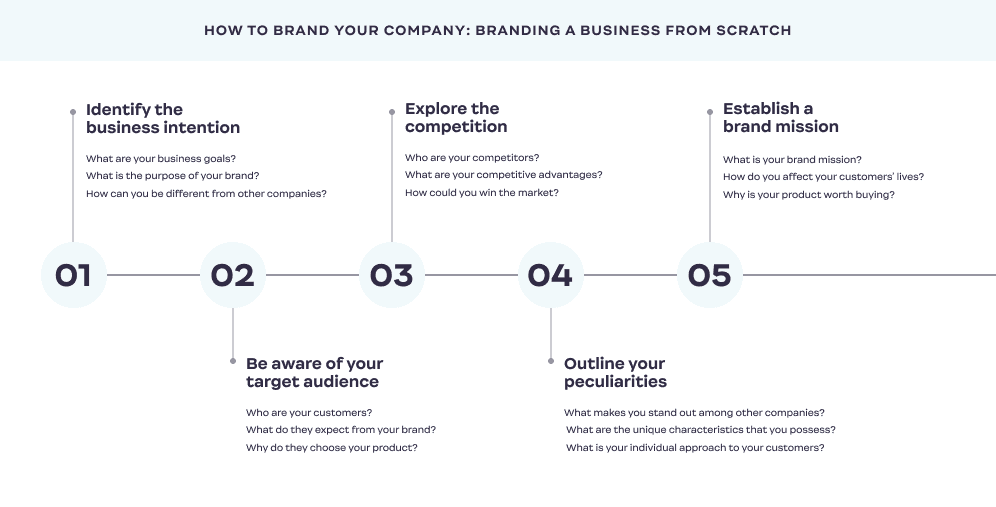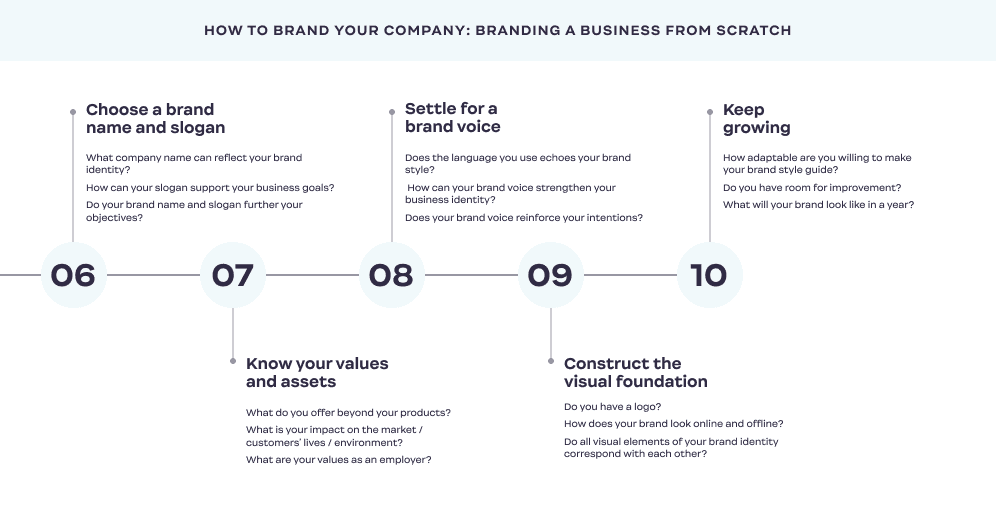Outline:
In one of our previous posts, we discussed the meaning of brand, its various types, and its significance for business. As a customer-centric company, we understand the value of providing our readers with all the relevant information they need, so they don’t have to go through the trouble of searching our website or leaving angry comments.
As an experienced provider of brand identity services, we are passionate about creating and enhancing a company’s unique business personality through effective branding.
So, what exactly is branding? It refers to a marketing process that involves creating and applying a unique set of features to a business that makes it easily recognizable and distinct from its competitors. Effective branding fosters trust between customers and business owners. It assures clients that the business is competent and accomplished as it is represented by a specific visual style that aligns with the company’s values and objectives.
Creating a brand that stands out from competitors and attracts clients is essential for a business’s success. Many famous companies have achieved their status through an effectively implemented branding strategy.
We are here to share a step-by-step guide on how to brand your company.

Step #1 How to Brand Your Company: Defining Your Business Features
Before beginning your branding process, it is important to identify several aspects:
– your business objectives
– the purpose behind your brand
– values and unique features of your company as an industry player.
These points will distinguish your company from other similar products or service providers in the market.
To facilitate the branding process in the future, it is essential to clearly define your business purpose. Once you have analyzed the basic elements, you will be able to see the whole picture more easily.
Defining a brand’s personality is a complex concept, but by exploring the core of what you do, you can think of associations that your brand evokes. This will help you understand the tone of your brand voice and the imagery that can be used in relation to your company. In addition, a clear identification of your purpose will help team members feel a more personal attachment and responsibility, increasing their work performance and employer loyalty.
To gain a deeper understanding, check out the article on what is corporate identity and learn how it shapes your brand’s overall perception and coherence.
Step #2 Get to Know Your Audience: The Importance of Targeting in Branding
Once you have identified your unique features, the next step in building a brand from scratch is to conduct research on your target audience. This is crucial if you want to know what your potential clients expect from your company.
To create an effective product or service, it is essential to know to whom you are appealing. It is a common misconception that a product or service can be equally useful and alluring for everyone. However, it is impossible to impress everyone, and senselessly shooting for a broad audience is not a good working strategy. Successful brands have specific target audiences and know their needs.
Think of your product or service as a journal that you tailor to a certain group of people with specific behavior and market it as such. By doing so, you are guaranteed to gain their attention, trust, loyalty, and ultimately, profit. In this way, everyone wins!
To become a long-standing player in your industry, it is vital to have a devoted audience. Therefore, take the time to study your potential clientele, as their needs and behavior will affect all your branding decisions along the way.
Step #3 Researching Your Rivals: Gain a Competitive Edge for Your Brand
To shape your original business individuality, it is not only significant to learn about your customers but also to study your competitors’ pool. By understanding what makes your product special among similar products, you can highlight and emphasize the unique points and stand out from the crowd.
Furthermore, studying your competitors can teach you what strategies work and what does not, what potentially can work for you, and what to avoid. However, it is important to note that imitation or parody of your competitors is not the goal at this point. While stealing what works for you is acceptable, imitation will not attract the same devoted fanbase that these brands have. Therefore, it is advisable to focus on distinguishing your brand from others rather than applying the same branding approach.
Step #4 Highlighting Your Uniqueness: Outline Your Brand’s Peculiarities
This point is closely tied to the previous one. Consider your unique attributes and approach to visual content arrangement. While you don’t need to panic if your style is similar to other brands, it is essential to develop something exclusive to your brand.
Creating exclusivity doesn’t necessarily mean that your product needs to be entirely unique. You can provide extra services that other companies do not offer or promote values and approaches that are not widely prevalent. For instance, the Ester Digital team recently worked on a branding strategy for Evryman – a mental healthcare platform that provides retreats for men to deal with modern-day challenges.
Although our website design approach for Evryman was not revolutionary, we highlighted their brand mission and the sense of community and belonging they provide to clients by utilizing their visual attributes, such as color, logo, and typographic elements. At this stage, it is important to understand how you can be original without being excessive and identify the potential tools that can help you achieve this.
Step #5 The Power of Purpose: Creating a Brand Mission
If you are still unsure of what your company brings to the table, formulating a brand mission can help clarify your purpose. You may ask yourself if your mission is to simply provide a product or service, make customers’ lives easier, entertain them, or assist them in something specific. Perhaps you offer a luxurious service to improve their quality of life.
The decision of what your company should promote solely depends on you and can be carefully planned out. Nike is a prime example of a corporation that does this well. Known worldwide for its high-quality footwear and sportswear, Nike also motivates its customers to pursue their fitness goals and unlock their inner athlete.
This is a fantastic example of a compelling brand mission that guides all the company’s decisions without being pushy or intense. When you purchase Nike products, you know what you are getting: excellent quality products, inspiration to use them, and a sense of belonging to an exclusive group.

Step # 6 Naming Your Brand: How to Make a Lasting Impression
Once you have completed the research basics, it is time to focus on the heart of your branding efforts. In today’s fast-paced world, it is impossible to imagine a company without a captivating name and a slogan that can quickly catch a client’s attention.
Choosing a name and a slogan for your brand is a significant responsibility because it influences every brand decision you make, including the length and form of your logo, website arrangement, and marketing strategy. The name you choose should depend on the nature of your business and the niche you are targeting. For instance, luxurious brands can afford to have longer names, while brands that appeal to a wider and less condensed audience should opt for shorter names.
When it comes to creating a slogan, it should be consistent with your brand mission and style. To make it interesting, you can follow the standard advice: create a slogan that impresses you before trying to impress anyone else. There are many options to consider when choosing a name and slogan for your brand, from using your mother’s maiden name to creating a neologism, playing with words, reinventing them, and giving them new meanings. The endless possibilities make it both exciting and challenging.
Step #7 Understanding the Key Elements of Your Brand: Values and Assets
When considering purchasing a product or service, it is important to ask yourself if the company offering has a clear set of values and advantages that make it stand out among its competitors. For example, if you’re buying a car, would you prefer a dealer that is conscious of its ecological impact or one that provides extra safety measures for drivers?
Spring Health serves as an excellent example of a company that is acutely aware of the importance of its work. With mental healthcare problems on the rise, Spring Health places the psychological comfort of its patients at the forefront of its mission. The company’s values are clear and focused on providing swift and competent help from highly skilled professionals, personalized recommendations, scientifically proven solutions, and the use of technology and AI-driven tools.
In addition to its core values, Spring Health also provides unique competitive advantages. For instance, the company offers mental healthcare programs for employers, enabling them to provide their staff with professional help and personal care navigators in the workplace. This feature highlights the individuality of the company and emphasizes the benefits that it provides. By offering such a personalized service, Spring Health stands out among its competitors due to additional value for its clients.
Step #8 Developing Your Brand Voice: Tips for Creating a Consistent Tone
Before creating the visual attributes of your brand, it’s crucial to ensure that your brand voice is clear and prominent across everything you do. By establishing your brand voice before implementing your brand identity elements, you can avoid the need for significant changes later on after the project is launched. While it is possible to go without a brand voice, having one will help you make more informed choices regarding your brand attributes.
It is important to choose a brand voice that reflects the nature of your business and your personal communication style. However, once you establish your brand voice, it can be difficult to change it after the visual elements are in place.
In addition to your brand voice, the language you use also matters. The linguistic choices you make can affect your customers’ perception of your brand. If you offer high-end services, using conversational phrases and internet slang may not be appropriate. Conversely, appealing to a younger, more “hip” audience may not require Shakespearean English, but it should still maintain a professional tone.
It’s vital to remember that you are communicating with your clients, even if it’s through a screen. Therefore, it’s crucial to approach communication in the same way you would in real-life situations. By being mindful of your brand voice and language, you can create a strong and cohesive brand that resonates with your target audience.
Step #9 Establishing Your Brand Identity: Create a Visual Foundation
Finally, it’s showtime. This step requires a thorough approach, making it incredibly time-consuming. However, if you commit to it with the utmost dedication, the results will be immensely powerful. Begin by making a list of things you need to work on.
Typically, a visual design package includes a logo, a color palette, typography, and imagery. We have already covered logo design in our blog (which you should check out!), where we explained that a logo is one of the most vital components of brand identity. It will feature on every marketing item that you put out under your company’s name into the world, so take your time with it. Create templates, work on various versions, play around with the form and colors, and test it for an audience. Ensure it is in line with the company’s mission, as we did for μKERA, where we turned their innovative approaches into a modern visual decision.
Although a color palette isn’t as crucial as a logo, it still plays an essential role in supporting the consistency of your brand identity elements and enhancing your brand recognizability. Certain colors evoke specific emotions, so be sure to consider them before picking a color scheme. Rely on the background research information you have accumulated in the previous steps, define the associations you want your clients to have with your brand, and go for it.
Unlike color palettes, creative and original typography can significantly shape your company’s future. There are countless typography trends in 2023. However, ensure that typographic elements you use support your general brand strategy and are not out of tune with it. If you opt for an austere approach to design, using intricate, rococo-inspired fonts might be confusing for customers.
Regarding illustrations, the choice is entirely up to you: this is an area in which you can make bold decisions. The main thing to remember, as with all of these elements, is that consistency is vital. You won’t be able to form a bond with your customers if they can’t grasp the overall style and feel.
If you’re interested in creating your brand attributes, such as those mentioned above, please contact us. We assure you that your design vision will be turned into reality with maximum efficiency and creativity.
Step #10 Scaling Your Brand: Best Practices for Long-Term Success
Once you have all the visual elements, a clear brand voice, and established business goals, it’s time to move on to the final step of ensuring a consistent and enjoyable customer experience every time they interact with your brand.
To achieve this, you need to integrate all the elements you created in the previous steps into various outlets such as your website, social media, packaging materials, ads, and marketing presentations. It is essential that all of these elements are in tune with each other and aligned with your overall branding strategy. Providing a homogenous customer experience is vital for building brand loyalty and trust.
While consistency is critical, marketers must also remain flexible. Even after months of shaping a brand personality, unforeseen circumstances can arise, such as customers losing interest in certain products or competitors introducing innovative approaches and products. It’s okay to evolve, change, and rebrand as needed.
A brand style guide is a convenient option to rely on during various implementation stages and to easily introduce possible adjustments. It serves as a unified brand identity code that greatly simplifies the process of maintaining brand coherence and harmony, even during times of change.
On a Final Note
As evident from the length of this article, branding requires a complex and detailed development process. Although the process may seem tedious, it is worthwhile as an effective branding strategy can help companies achieve their ultimate goals – building a distinguished and robust brand with a loyal customer base and an excellent reputation among industry peers.
As we come to the end of this guide, we would like to provide some final tips to help you wrap up the branding process. While we won’t go over the importance of consistency, as we’re sure you’re already aware of it, we do want to highlight some other paramount factors to consider.
- Integrate seamlessly: Every brand element should be in sync with the others. For example, if your logo features a certain color palette, ensure that the color of your packaging materials complements it, creating a cohesive product.
- Know your dos and don’ts: Identifying both the paths you’d like to pursue and those you wouldn’t is essential in influencing your branding decisions.
- Steal wisely: Being inspired by other brands is normal, but direct copying will not produce the desired outcome.
- Stay alert: Maintaining a successful brand identity is challenging. Think of it like building a ship – you lay the foundation, test it, and set out into the unknown. Be prepared to make informed decisions as you go along.
In conclusion, branding is hard work, but good branding may be a double return on your efforts.
If you have any questions or need help with brand development, contact us, and we will provide everything to make you covered on this theme.




